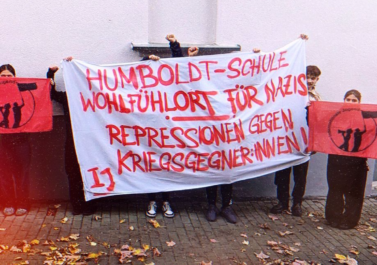
This is the third part of an article series by the German collective Wildcat on the current global situation of bloc confrontation and war. You can read part 1 and part 2 here. This part deals with the relation between energy transition and global imperialist tension. These issues are not detached from our daily struggles against exploitation, e.g. the future attacks on the automobile and wider industrial workers in the northern hemisphere will be conducted with an ideological background music of ‘ecology’ and ‘western democracy’ against the ‘polluting’ eastern ‘dictatorships’.
Historically speaking it was the accumulated emissions of Europe and North America that have caused global warming, but since 2006 China is the world’s main producer of CO2 emissions. In recent years, China has built 95% of the world’s new coal-fired power plants and currently emits around 30% of global CO2 (the US just under 14% and the EU around 7%); this is more per capita than the whole of Europe, despite the massively larger population in China! But China also installed more solar capacity in 2023 than the US has in its entire history and accounts for half of the global increase in renewable energy sources by 2027. In several ‘green’ industries, China has taken the technological lead and dominates world markets (photovoltaics, wind turbines, electric vehicles, storage batteries, high-speed trains). It is also a world leader in power grids, especially in ultra-high voltage technology. [1]
Differences in industrial policy
The investment rate in China is about twice as high as in the West. China’s ‘industrial policy’ is more comprehensive and targeted. According to an OECD study, Chinese companies receive an average of 3.7% of their revenue in state subsidies. In the OECD countries, these amount to 0.4% of revenue, mainly in the form of tax breaks that give employers a free choice to invest like they wish to. In China, state-owned banks issue earmarked loans and retain control over allocation of investments. More crucially, however, China’s subsidies promote innovative industries, while most US industrial policy measures are designed to protect weak and struggling industries. A recent study by IMF economists Cherif and Hasanov shows that the latter approach of ‘import substitution’ undermines long-term growth because it creates ‘overly pampered, inefficient industries.’ [2]
China has successfully countered some of the US sanctions. For example, the US blacklisted Huawei in 2019. In 2022 and 2023, the Chinese state doubled its subsidies and ensured that they were channelled primarily into research and development. Sales in China rose sharply. In 2023, profits doubled. [3]
Just like the ‘Plaza’ crisis, Obama’s defensive measures were quite successful: US imports of Chinese solar panels fell by 86% between 2012 and 2020. But since the introduction of tariffs in 2010, the global market share of US solar companies has fallen from 9% to 2% today. Over the same period, the Chinese share has risen from 59 to 78%. Billions in subsidies have done little to advance the US industry. The EU also wanted energy security through the electrification of transport, industry and housing. Instead, the ‘green energy transition’ is creating new geopolitical dependencies. Without China, electricity production from renewable sources cannot be ramped up and the grids cannot be expanded fast enough. Without China, there will also be no rapid and general switch to the electric car.
The electric car and the return of mining
With the electric car, another part of the ‘green transformation’ may be heading towards a crash. It was supposed to help the automotive industry out of its crisis and end geopolitical dependence on oil. However, it is exacerbating dependence on China – not only for raw materials, but also for the manufacture of key parts such as batteries. And electric vehicles are only affordable if they are manufactured in China. For years, the car industry has been sliding into crisis. In 2017, global annual sales had reached their peak at over 85 million cars. Since then, they have fallen to an average of under 70 million – with a production capacity for over 100 million cars. To reduce the overcapacity of 30 million cars, 60 large factories would have to be closed.
E-cars are selling badly. All electric car start-ups are currently reducing capacity or going bankrupt. Tesla is laying off people and has suspended the construction of its fifth factory (in Mexico). VW is laying off people in electric car production. Car companies still only make a profit from combustion engines. In late May 2024, ‘Horse Powertrain Limited’ was founded in London – a joint venture between Renault and the Chinese car company Geely, which plans to build five million combustion engines a year with 19,000 employees and 17 factories.
In the 1960s, the Ruhr region in Germany proclaimed the transformation of miners into car workers as a successful example of structural change. The electric car is going back underground. To produce a standard 60 kWh battery, which weighs 185 kg and accounts for a quarter of the price of an electric car, you need 52 kg of graphite, 35 kg of aluminium, 29 kg of nickel, 20 kg of copper, 20 kg of steel, 10 kg of manganese, 8 kg of cobalt, 6 kg of lithium and 5 kg of iron. To extract these raw materials, mining must be expanded again. This not only ruins the planet, but also means the return of life-threatening (child) labour. [4] Since 2010, graphite mining has increased by a third, nickel and cobalt mining has more than doubled, and lithium mining has increased more than sixfold. A quarter of the world’s lithium is mined in Chile; in a Chilean desert area, 2,000 tonnes of water are used for each tonne of lithium. Half of the known cobalt deposits are in the DR Congo, and three quarters of the cobalt processed worldwide comes from there. Cobalt could be replaced by nickel and manganese; but to do that, the manganese nodules would have to be extracted from the deep sea, with extreme risks to the marine ecology.
There is resistance to the massive environmental impact of lithium mining. For years, residents of the Upper Rhine region have been protesting against Vulcan Energy (earthquake risk!). In Bosnia, people are fighting against the Swiss company Arcore AG, which wants to supply lithium to Mercedes. In Serbia, protests in 2021 had prevented a new lithium mine. At the beginning of July 2024, the Serbian constitutional court finally approved the mining. Chancellor Scholz and Mercedes CEO Källenius personally travelled to Serbia to sign the declaration of intent. According to the Serbian government, mining will not begin before 2028. Meanwhile, the resistance continues on a massive scale. In North America, there are not enough profitable exploitable cobalt, nickel, manganese and graphite deposits to become independent of China. That is why Australia and the United Kingdom were summarily defined as ‘domestic sources’ in 2024 with the National Defense Authorization Act and can thus receive funds from the Defense Production Act, which finances mining and processing projects. To set up a domestic capacity for battery production, would require an investment of $920 billion. But would it take too long to build such an infrastructure? On average, it takes 15.7 years to develop a new mine – and just two years to build a (Chinese!) battery factory.
China’s dominance
In 2022, Chinese companies were producing about 70% of all rare earths and 68% of graphite worldwide. [5] When it comes to processing these raw materials, their share was as high as 85%; this is a rather dirty business from which Western companies had withdrawn in order to concentrate on the ‘higher-value’ (more profitable) steps in the value chain. As part of the Belt and Road Initiative, China has invested heavily in mining worldwide. It controls many cobalt mines in Congo and nickel mines in Indonesia.
China is the only country that can produce an electric car completely without foreign suppliers. BYD has overtaken Tesla as the world’s largest electric carmaker in terms of sales figures. The company, which has 700,000 employees, is vertically integrated and only sources tyres and windows from outside suppliers. It operates its own fleet of ships to bring the cars to Europe. With factories outside China, BYD aims to circumvent import duties and sanctions. In June 2024, a factory was opened in Thailand, and others are under construction or in the planning stage in Uzbekistan, Turkey, Hungary, Indonesia, Mexico and Brazil.
In 2012, Chinese electric cars had a global market share of 0.1% – today it is 60%. Half of all Teslas are also produced in China. Car exports from China more than doubled from 2021 to 2023, with the share of electric cars rising from 15 to 25%. Chinese electric cars cost an average of €32,000, while German ones cost €52,700. In China itself, BYD sells its cars starting at €11,000. For four years, German manufacturers have been losing market share in their most important sales market. In response to this and to the US government’s tariff increase, the EU is planning to impose import tariffs of between 17 and 38% on electric cars produced in China. This will also affect German carmakers that produce in China and export from there to the US and EU. German suppliers and medium-sized companies, on the other hand, are in favour of the tariffs because they are losing shares of the global market to China, due to China’s supremacy when it comes to technology and price. In addition, the back and forth between electric cars and combustion engines is causing them serious problems. They are facing mass layoffs and bankruptcies.
In terms of industrial policy, the tariffs are an admission of failure. “Lacking any better explanation, they tell us that it’s about national security, that electric cars are spy machines on four wheels and that Beijing can shut down wind turbines via satellite. There is something desperate about the EU’s aggressive trade policy against China,” even the mainstream German daily FAZ commented. [6]
Worldwide overcapacity in battery production
The Inflation Reduction Act has led to a battery factory construction boom. In 2019, there were two Factories in the US and another two under construction. In 2024, 11 are in operation or starting up and 22 are under construction or in the planning stage. By 2030, US battery production is expected to quadruple to over 1,000 gigawatt hours per year; that would be enough for the (planned) ten million electric cars annually. Volkswagen is planning its largest cell factory in Canada – subsidised with several billion Euros. European battery manufacturers are unable to ramp up production. The EU member states have subsidised battery production with 6.1 billion Euros since 2019. But most subsidised projects either end in technical problems (see Northvolt) or have gone bust: 137 million went to Varta – which is now facing bankruptcy at the end of July, while the subsidies are gone.
Two-thirds of the world’s lithium-ion batteries are built in China, with BYD and CATL alone producing more than half. The coating machines for anodes and cathodes of the batteries also come from China. By 2030, the country will have more than four times the battery production capacity of the US. Chinese battery companies are planning foreign investments of over 70 billion euros in the next few years, most of them in Europe. In 2023, 44 percent of all Chinese direct investments in Europe went to Hungary. In Eastern and Southeastern Europe, China has now overtaken Germany and Austria, which have traditionally been the largest investors.
Globally, there will be enough factory capacity by the end of 2025 to produce almost 8,000 GWh of batteries, three quarters of them in China. However, forecasts predict only 1,600 GWh of demand (the majority for electric cars). Despite the fact that Chinese manufacturers alone could cover three to four times the global demand for batteries, everyone else is also building their own factories.
New workers’ struggles?
The production of electric cars spreads miserable working conditions and intensified destruction of nature across the globe, but the race for national industrial capacities also leads to new opportunities for workers’ struggle. The Tesla plant in Grünheide near Berlin is an example of both.
Replacing the combustion engine with electric motors reduces assembly work. But if you look at the entire (upstream) production and supply chain, more rather than less work is needed to manufacture an electric car. [7] If the children in Congo had standard wages, an electric car would be unaffordable anyway. The crucial question is whether the electric car can be used by employers to escape collective bargaining. The new battery factories in the US were not supposed to be covered by the UAW collective agreement. With the strike in 2023, the workers were able to prevent this and improve their conditions. In Grünheide, residents and climate activists are protesting against the expansion of the factory, while workers and IG Metall are fighting for a collective agreement. Tesla employees are also fighting for collective agreements in Scandinavia.
Footnotes
[1] »China: Wo der Ausbau von Solarenergie und Windkraft atemberaubend ist« FAZ 22nd of June 2024. The article by Adam Tooze is comprehensive »Klimapolitik – Die Zukunft der Menschheit liegt in Chinas Händen« ZEIT 29th of July 2024
[2] IMF Working Paper, »The Return of the Policy That Shall Not Be Named: Principles of Industrial Policy« 26th of March 2019
[3] »The U.S. Wanted to Knock Down Huawei. It’s Only Getting Stronger«, Wall Street Journal 29th of July 2024
[4] Siddharth Kara, author of ‘Cobalt Red’ (HarperCollins 2024), who spent a considerable time researching the situation in the DR of Congo said that he never witnessed any efforts of multinational corporations to adhere to international human rights standards or audits by third parties regarding child or forced labour.
[5] China produces 70.3% of all rare earths (combined) and has 35% of the reserves, while Russia has 16.7%. In terms of reserves, only Brazil – another country in the BRICS group – plays an important role (16.7%), though almost nothing is currently being mined there. From January to November 2022, Germany imported around 66% of its rare earths from China. In 2023, the Chinese government imposed export restrictions on germanium, gallium and graphite.
[6] Hendrik Kafsack: »Zölle auf E-Autos: Handelspolitik unter China-Schock«, FAZ 16th of July 2024.
[7] See Mark P. Mills: The EV Jobs Myth, www.city-journal.org, 21st of September 2023 and Emily Pontecorvo: ‘There’s Surprisingly Little Evidence That EVs Will Require Fewer Workers’, www.heatmap.news, 6th of October 2023



